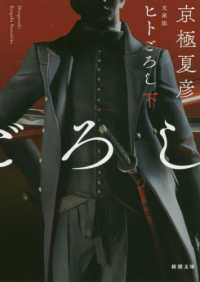Full Description
Diderot was one of the most important philosophical thinkers of the French Enlightenment. His works are also milestones in theater history. This book is the first study to contextualize Diderot's acting theory, as presented in the Paradoxe sur le comédien, within the broader landscape of eighteenth-century material culture, centering on four humanoid objects: the automaton, the statue, the jumping jack, and the mannequin, which Diderot employs as metaphors to articulate his ideas on acting. The book shows how the metaphorical use of these four objects is shaped by their material characteristics and distinct functionality in everyday life.
Diderot's humanoid objects demonstrates that a deep dive into eighteenth-century material culture is necessary to fully acknowledge Diderot's aesthetic and anthropological concept of the ideal actor/actress. Thus, the book recovers aspects of Diderot's acting theory that have been eclipsed by subsequent theater practitioners and theoreticians interested in humanoid objects as role models for actors (such as Kleist, Craig, Meyerhold or Schlemmer). It also sheds new light on the humanoid objects present in Diderot's novels and Salons, thereby offering fresh insights into how people in the eighteenth century understood themselves in relation to mechanisms or machines - be it in cultural, societal or political contexts.
Contents
Acknowledgements
Notes on Citations
Introduction
Conceptual Background
Philosophical context
Approach, method, & material
Chapter outline
Part I: Actors & Mechanisms
Theatrical automata
Automatic simulators
A symbold for bad actors
Diderot's strategy
The limits of automation
Sensitive machines
Moralizing spasms
The Cartesian passions & the sensibility doctrine
Monism versus dualism
Dreaming bodies
Part II: Society & Authority
The actress-automation
Superficiality, rigidity, & artificiality
Moral & immoral acts of dissimulation
The Ancien Régime's isolated subjects
Mechanisms of obedience
The mechanics of fear
Politics of anxiety
Diderot versus Hobbes
Satire & Subversion
The society of jumping jacks
Subversion of power relations
About mechanisms and organisms
Part III: Mimesis & Ideal
Artists & tools
Clothed anatomy
Shortcomings
Spatial models
Mannequins & role models
Point of orientation & place holder
The actor's two bodies
Materiality & malleability
Conclusion
Part I: Actors & Mechanisms
Part II: Society & authority
Part III: Mimesis & ideal
Perspectives: Art & research
List of Illustrations
Works cited








